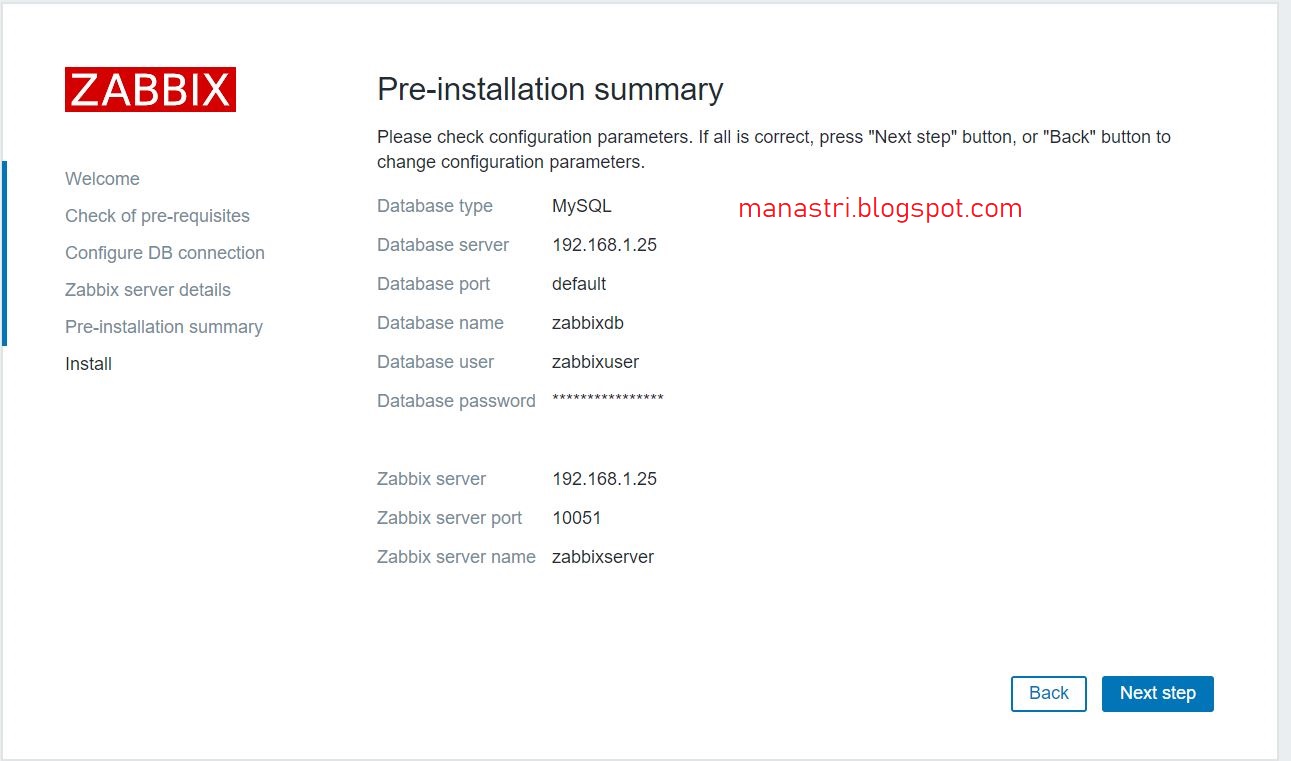How to Install Zabbix 4.4 in RHEL/CentOS 7
How to Install Zabbix 4.4 in RHEL/CentOS 7
Set the SELinux in disabled mode, use the following command and reboot your server:
[root@zabbixserver ~]# sed -i 's/^SELINUX=.*/SELINUX=disabled/g' /etc/selinux/config
[root@zabbixserver ~]# reboot
[root@zabbixserver ~]# reboot
Install apache and mariadb
[root@zabbixserver ~]# yum update
[root@zabbixserver ~]# yum install httpd mariadb-server -y
[root@zabbixserver ~]# yum install httpd mariadb-server -y
Start Apache and mariaDB Services.
[root@zabbixserver ~]# systemctl enable httpd && systemctl start httpd
Created symlink from /etc/systemd/system/multi-user.target.wants/httpd.service to /usr/lib/systemd/system/httpd.service.
[root@zabbixserver ~]# systemctl enable mariadb && systemctl start mariadb
Created symlink from /etc/systemd/system/multi-user.target.wants/mariadb.service to /usr/lib/systemd/system/mariadb.service.
[root@zabbixserver ~]#
Created symlink from /etc/systemd/system/multi-user.target.wants/httpd.service to /usr/lib/systemd/system/httpd.service.
[root@zabbixserver ~]# systemctl enable mariadb && systemctl start mariadb
Created symlink from /etc/systemd/system/multi-user.target.wants/mariadb.service to /usr/lib/systemd/system/mariadb.service.
[root@zabbixserver ~]#
Set Mariadb root Password:
Please refer mysql_secure_installation.
Install Zabbix Server with MySQL
Before starting the installation we need to enable the zabbix repository using this commands:
[root@zabbixserver ~]# rpm --import http://repo.zabbix.com/RPM-GPG-KEY-ZABBIX
[root@zabbixserver ~]# rpm -ivh https://repo.zabbix.com/zabbix/4.3/rhel/7/x86_64/zabbix-release-4.3-3.el7.noarch.rpm
Retrieving https://repo.zabbix.com/zabbix/4.3/rhel/7/x86_64/zabbix-release-4.3-3.el7.noarch.rpm
warning: /var/tmp/rpm-tmp.JFk5lA: Header V4 RSA/SHA512 Signature, key ID a14fe591: NOKEYPreparing... ################################# [100%]Updating / installing...
1:zabbix-release-4.3-3.el7 ################################# [100%]
[root@zabbixserver ~]#
[root@zabbixserver ~]# rpm -ivh https://repo.zabbix.com/zabbix/4.3/rhel/7/x86_64/zabbix-release-4.3-3.el7.noarch.rpm
Retrieving https://repo.zabbix.com/zabbix/4.3/rhel/7/x86_64/zabbix-release-4.3-3.el7.noarch.rpm
warning: /var/tmp/rpm-tmp.JFk5lA: Header V4 RSA/SHA512 Signature, key ID a14fe591: NOKEYPreparing... ################################# [100%]Updating / installing...
1:zabbix-release-4.3-3.el7 ################################# [100%]
[root@zabbixserver ~]#
Now use the below command to install Zabbix and necessary packages
[root@zabbixserver ~]# yum install zabbix-server-mysql zabbix-web-mysql zabbix-agent zabbix-get zabbix-sender zabbix-java-gateway -y
Edit PHP timezone
Open the file /etc/httpd/conf.d/zabbix.conf created by Zabbix with your favorite editor.
[root@zabbix ~]# vi /etc/httpd/conf.d/zabbix.conf
It’s necessary to uncomment the “date.timezone” setting and replace it with your timezone:
php_value date.timezone Asia/Kolkata
Save the file and don’t forget to restart httpd service using the below command:
[root@zabbix ~]# systemctl restart httpd
Edit create and import initial zabbix database and user
First we need to create zabbix database (zabbixdb) and create a zabbix user (zabbixuser).
[root@zabbixserver ~]# mysql -u root -p
Enter password:Welcome to the MariaDB monitor. Commands end with ; or \g.Your MariaDB connection id is 10Server version: 5.5.60-MariaDB MariaDB ServerCopyright (c) 2000, 2018, Oracle, MariaDB Corporation Ab and others.
Type 'help;' or '\h' for help. Type '\c' to clear the current input statement.
MariaDB [(none)]> CREATE DATABASE zabbixdb CHARACTER SET utf8 COLLATE utf8_bin;
Query OK, 1 row affected (0.00 sec)
MariaDB [(none)]> GRANT ALL PRIVILEGES ON zabbixdb.* TO zabbixuser@localhost IDENTIFIED BY "Your Password";
Query OK, 0 rows affected (0.00 sec)
MariaDB [(none)]> FLUSH PRIVILEGES;
Query OK, 0 rows affected (0.00 sec)
MariaDB [(none)]> exit
Bye
[root@zabbixserver ~]#
Enter password:Welcome to the MariaDB monitor. Commands end with ; or \g.Your MariaDB connection id is 10Server version: 5.5.60-MariaDB MariaDB ServerCopyright (c) 2000, 2018, Oracle, MariaDB Corporation Ab and others.
Type 'help;' or '\h' for help. Type '\c' to clear the current input statement.
MariaDB [(none)]> CREATE DATABASE zabbixdb CHARACTER SET utf8 COLLATE utf8_bin;
Query OK, 1 row affected (0.00 sec)
MariaDB [(none)]> GRANT ALL PRIVILEGES ON zabbixdb.* TO zabbixuser@localhost IDENTIFIED BY "Your Password";
Query OK, 0 rows affected (0.00 sec)
MariaDB [(none)]> FLUSH PRIVILEGES;
Query OK, 0 rows affected (0.00 sec)
MariaDB [(none)]> exit
Bye
[root@zabbixserver ~]#
After creating the Zabbix database and user we need to import the zabbix initial database using the below commands:
[root@zabbixserver ~]# zcat /usr/share/doc/zabbix-server-mysql*/create.sql.gz | mysql -u zabbixuser -p zabbixdb
Now we need to edit database configuration in the Zabbix server configuration file zabbix_server.conf
[root@zabbix ~]# vi /etc/zabbix/zabbix_server.conf
Specify the database name for zabbix , database user name and the password
DBHost=localhost
DBName=zabbixdb
DBUser=zabbixuser
DBPassword=YOUR_PASSWORD
Specify the database name for zabbix , database user name and the password
DBHost=localhost
DBName=zabbixdb
DBUser=zabbixuser
DBPassword=YOUR_PASSWORD
Now enable and start zabbix service
[root@zabbixserver ~]# systemctl enable zabbix-server
Created symlink from /etc/systemd/system/multi-user.target.wants/zabbix-server.service to /usr/lib/systemd/system/zabbix-server.service.
[root@zabbixserver ~]# systemctl start zabbix-server
[root@zabbixserver ~]# systemctl enable zabbix-agent
Created symlink from /etc/systemd/system/multi-user.target.wants/zabbix-agent.service to /usr/lib/systemd/system/zabbix-agent.service.
[root@zabbixserver ~]# systemctl start zabbix-agent
[root@zabbixserver ~]#
Created symlink from /etc/systemd/system/multi-user.target.wants/zabbix-server.service to /usr/lib/systemd/system/zabbix-server.service.
[root@zabbixserver ~]# systemctl start zabbix-server
[root@zabbixserver ~]# systemctl enable zabbix-agent
Created symlink from /etc/systemd/system/multi-user.target.wants/zabbix-agent.service to /usr/lib/systemd/system/zabbix-agent.service.
[root@zabbixserver ~]# systemctl start zabbix-agent
[root@zabbixserver ~]#
Setup Zabbix Web Frontend
Navigate to http://ip_address/zabbix or http://host_name/zabbixMake sure all configurations are ok.
Please enter DB details:
Please enter Zabbix Server details:
Summary:
Finish the installation:
Login Prompt:
Default username and password is "Admin" & "Zabbix"
Zabbix dashboard:
Other Articles on Zabbix:
How to Add Host in Zabbix Server to Monitor
How to install Zabbix Agent on CentOS / RHEL 6/7
How to Install Zabbix 4.4 on Ubuntu 18.04 / 16.04 and Debian 9/8
Interesting Articles on Kubernetes:
Kubernetes : Kubernetes Node Management, Maintenance, Delete
How to add a New Worker Node to a existing kubernetes Cluster
MinIO Client Installation and Quickstart
PLEG is not healthy: Kubernetes Worker Node is in "NotReady" state
Backup MySQL databases in Kubernetes
How to Run Automated Tasks in Kubernetes with a cronjob
How to Completely remove Kubernetes









0 Response to "How to Install Zabbix 4.4 in RHEL/CentOS 7"
Post a Comment